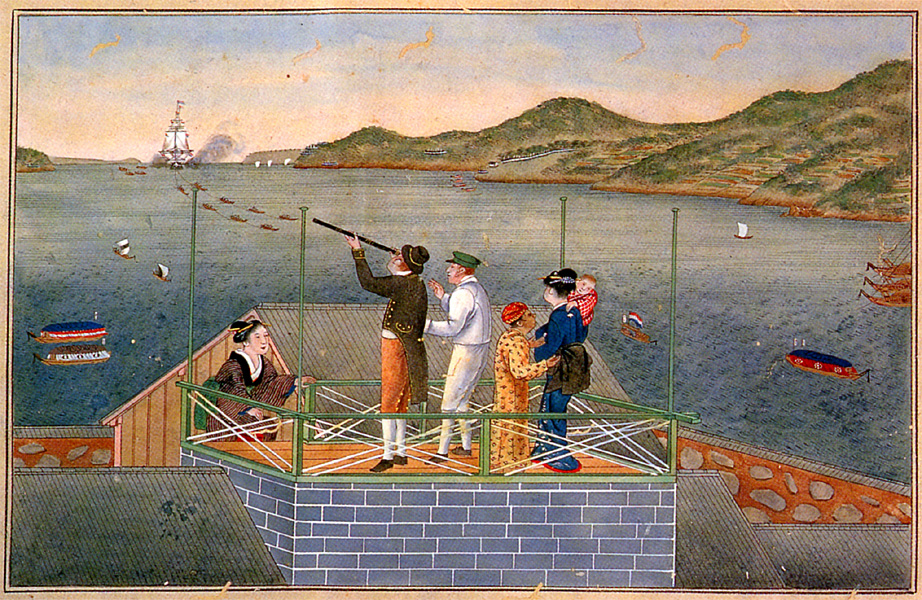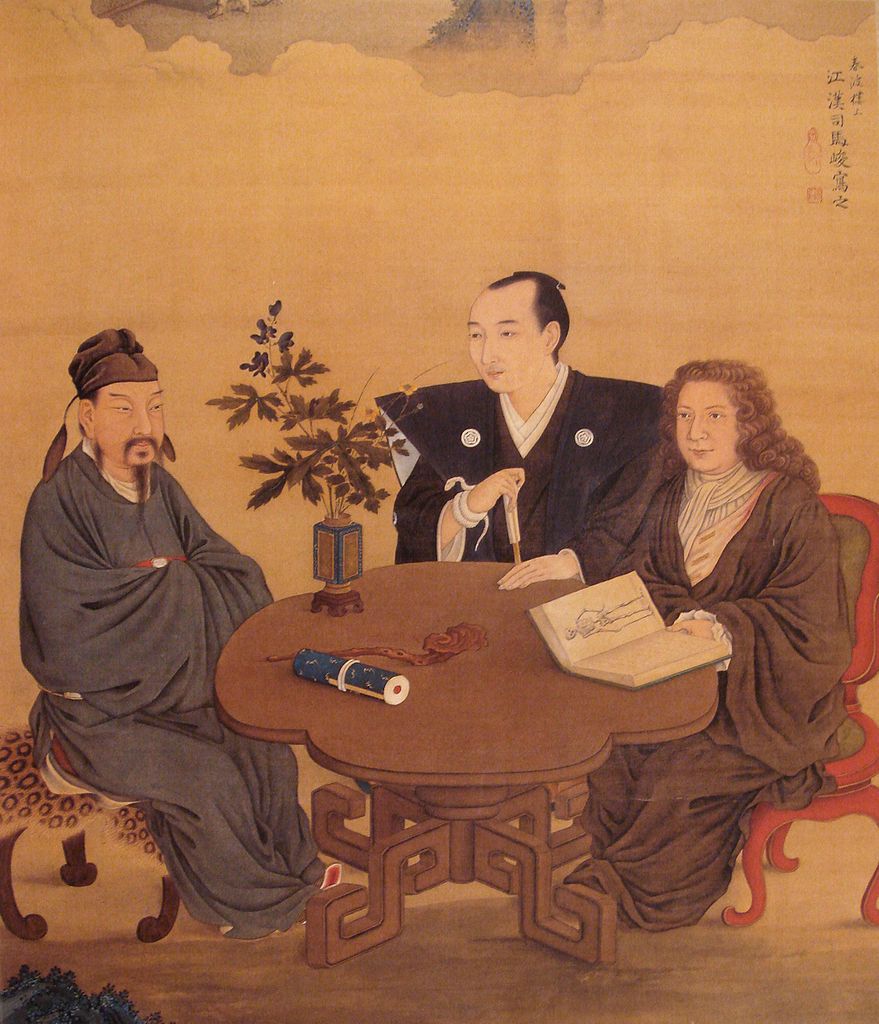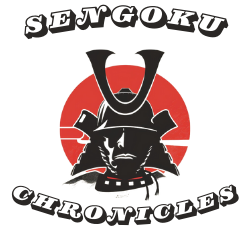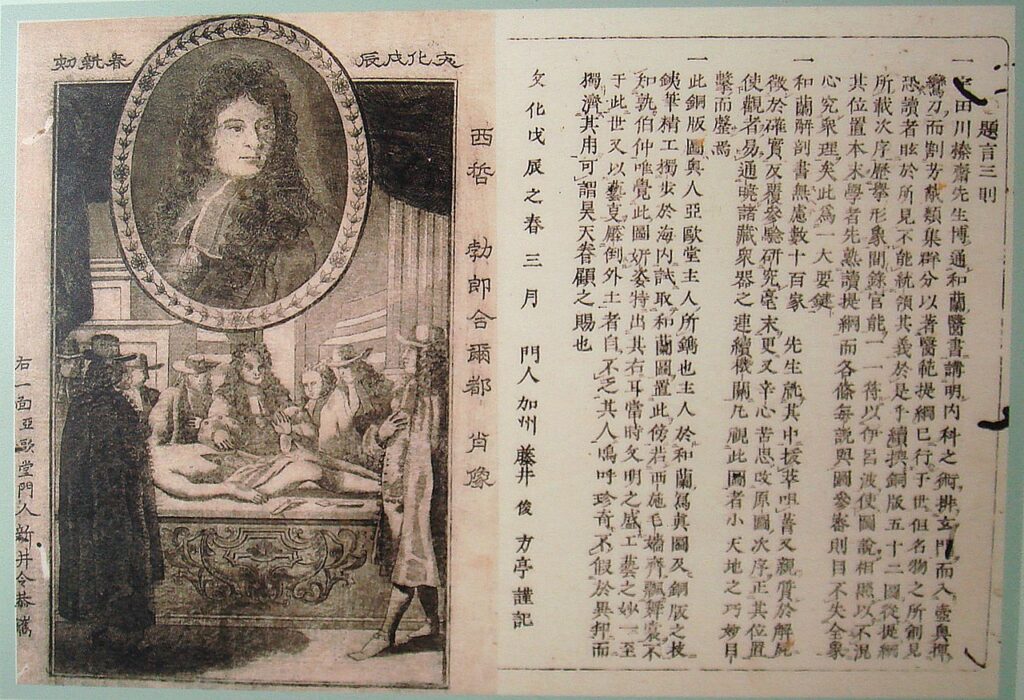Introduction
In the midst of Japan’s isolationist period, a remarkable movement known as Rangaku (jp. 蘭学), or “Dutch Learning,” began to take root, bridging the gap between East and West. Imagine a time when Japan, under the Tokugawa Shogunate, had largely closed its doors to the outside world. For over two centuries, from the early 1600s to the mid-1800s, Japan maintained a policy of sakoku, or national isolation, permitting only limited contact with foreign nations. Amidst this seclusion, the Dutch, uniquely allowed to trade through the small artificial island of Dejima in Nagasaki Bay, became Japan’s singular window to the West.
The Rangaku movement emerged as Japanese scholars started to embrace and study Western scientific knowledge brought by the Dutch. This movement was not merely a scholarly pursuit but a transformative force that played a crucial role in Japan’s transition from isolation to becoming a modernized nation. Through painstaking efforts to learn Dutch and translate Western texts, Japanese scholars gained access to advanced medical knowledge, astronomical observations, geographical discoveries, and technological innovations.
This blog post delves into the fascinating history of Rangaku, exploring its origins, key figures, and profound impact on Japanese society. We will journey through the corridors of time to understand how this movement laid the foundations for Japan’s rapid modernization during the Meiji Restoration. By examining the contributions of pioneering scholars like Sugita Genpaku, Hiraga Gennai, and others, we will uncover the stories of those who dared to look beyond the horizon and embrace the unknown.
Join us as we unravel the intricate tapestry of Rangaku, a testament to the power of knowledge and cultural exchange in shaping the future of a nation.
Historical Context
Tokugawa Shogunate and Sakoku
To fully appreciate the significance of Rangaku, it is essential to understand the broader historical context in which it emerged. The Tokugawa Shogunate, established in 1603 by Tokugawa Ieyasu, brought an era of relative peace and stability to Japan after a long period of civil war. To maintain this stability, the Tokugawa rulers implemented a policy of national isolation known as sakoku. This policy restricted foreign influence and strictly controlled trade and interactions with other nations, aiming to prevent the spread of Christianity and limit the power of foreign entities within Japan.

Arrival of the Dutch
Despite the widespread isolationist policies, the Tokugawa Shogunate permitted limited and highly regulated trade with a select few foreign nations. Among these, the Dutch East India Company (VOC) held a unique position. Unlike other European powers, the Dutch focused on commerce and did not aggressively promote Christianity. As a result, they were allowed to maintain a trading post on Dejima, a small, artificial island in Nagasaki Bay. Established in 1639, Dejima became the only place where direct contact between the Japanese and Europeans occurred for over two centuries.
Early Encounters
The initial interactions between the Dutch and Japanese were primarily commercial, but over time, these encounters led to a gradual exchange of knowledge. Japanese curiosity about Western science and technology grew, leading to the birth of Rangaku. Early encounters included the exchange of medical knowledge, scientific instruments, and books. These exchanges were facilitated by interpreters who learned Dutch to communicate with the traders and access the wealth of knowledge they brought with them.
The Dutch played a crucial role in introducing Western advancements to Japan, despite the constraints of sakoku. They provided Japanese scholars with access to Western books and scientific instruments, sparking an intellectual curiosity that laid the foundation for the Rangaku movement. This period marked the beginning of a transformative journey that would eventually lead Japan from isolation to becoming a modern, industrialized nation.
The Emergence of Rangaku
Definition and Scope
Rangaku, or “Dutch Learning,” refers to the body of knowledge and the intellectual movement that arose in Japan during the Edo period, primarily through interactions with the Dutch traders on Dejima. It encompassed various fields of Western science, medicine, technology, and culture, introduced to Japan by the Dutch. This knowledge exchange was crucial in shaping Japan’s scientific and technological advancements during a time when the country was largely isolated from the rest of the world.
Key Fields of Study
Rangaku was characterized by its broad scope, covering multiple disciplines. Some of the key areas of study included:
- Medicine: Western medical practices and anatomical knowledge were among the first and most significant subjects studied by Rangaku scholars. The introduction of advanced medical texts and techniques revolutionized Japanese healthcare.
- Astronomy: Western astronomical knowledge, including the use of telescopes and new understandings of celestial movements, intrigued Japanese scholars and led to advancements in Japanese astronomy.
- Geography: Western maps and geographic knowledge provided a more accurate understanding of the world, challenging and expanding the Japanese worldview.
- Technology: Various technological innovations, such as the introduction of mechanical devices and scientific instruments, were studied and adapted by Japanese scholars.
Learning Methods
The pursuit of Rangaku required Japanese scholars to overcome significant language barriers. Learning Dutch was essential for accessing Western knowledge, and this often involved painstaking efforts to translate Dutch texts into Japanese. Key methods included:
- Language Acquisition: Scholars like Hiraga Gennai and Sugita Genpaku dedicated themselves to learning Dutch, often relying on dictionaries and personal interactions with Dutch traders to improve their language skills.
- Translation Projects: Large-scale translation efforts were undertaken to make Western texts accessible to Japanese scholars. One of the most notable projects was the translation of the Dutch medical text “Kaitai Shinsho” (New Book of Anatomy) by Sugita Genpaku and his colleagues.
- Collaboration with Dutch Traders: Interpreters and scholars frequently collaborated with Dutch traders on Dejima, exchanging knowledge and clarifying complex scientific concepts. This collaborative learning environment facilitated a deeper understanding of Western science and technology.
Early Adopters
The early adopters of Rangaku were a small group of scholars who recognized the value of Western knowledge and were determined to incorporate it into Japanese society. Their efforts laid the foundation for the broader dissemination and acceptance of Rangaku ideas throughout Japan.
This initial phase of Rangaku set the stage for more comprehensive engagement with Western science and technology, ultimately contributing to Japan’s modernization efforts in the later periods.
Key Figures and Contributions
Sugita Genpaku
Sugita Genpaku is perhaps the most well-known figure associated with the Rangaku movement. As a pioneering physician, his contributions significantly advanced Japanese medical knowledge.
- Translation of Kaitai Shinsho: In 1774, Genpaku and his colleagues translated a Dutch anatomy book, “Ontleedkundige Tafelen” (Anatomical Tables), into Japanese, publishing it as “Kaitai Shinsho” (New Book of Anatomy). This work introduced detailed Western anatomical knowledge to Japan and marked a significant milestone in Japanese medical history.
- Medical Education: Genpaku’s efforts laid the groundwork for modern medical education in Japan, fostering a new generation of doctors trained in Western techniques.
Hiraga Gennai
Hiraga Gennai was a polymath and inventor who made significant contributions to various fields, embodying the spirit of Rangaku.
- Scientific Experiments: Gennai conducted experiments in electricity and created one of the earliest electrostatic generators in Japan. His work demonstrated the practical applications of Western scientific principles.
- Pharmacy and Medicine: He also worked on developing new pharmaceutical methods and medicines, integrating Western techniques with traditional Japanese practices.
- Literature and Art: Beyond science, Gennai was a prolific writer and artist, contributing to the cultural exchange between Japan and the West.
Otsuki Gentaku
Otsuki Gentaku was another influential figure in the Rangaku movement, known for his dedication to spreading Western knowledge.
- Educational Efforts: Gentaku established a Rangaku school in Edo (modern-day Tokyo), where he taught Western science and Dutch language to eager students. His school became a hub for Rangaku scholars.
- Publications: He authored several books on Western science and technology, helping to disseminate knowledge more widely across Japan.
Kawakami Toyohiko
Kawakami Toyohiko was a key translator and scholar who contributed to the translation and understanding of Western texts.
- Translation Works: Toyohiko translated numerous Dutch texts into Japanese, making a wide range of Western knowledge accessible to Japanese scholars. His translations covered various subjects, including medicine, astronomy, and geography.
- Advocacy for Western Learning: He was a strong advocate for the study of Western sciences, encouraging other scholars to pursue Rangaku.
Other Notable Figures
- Maeno Ryotaku: Collaborated with Sugita Genpaku on the translation of “Kaitai Shinsho” and contributed to the spread of Western medical knowledge.
- Ino Tadataka: Applied Western cartographic methods to create the first detailed and accurate map of Japan, which was completed in 1821.
These key figures and their contributions were instrumental in the development and dissemination of Rangaku in Japan. Their dedication to learning and teaching Western knowledge not only advanced scientific and medical understanding but also laid the foundation for Japan’s modernization. By integrating Western ideas with traditional Japanese practices, they paved the way for a new era of intellectual and cultural growth.

Impact on Japanese Society
Advancements in Medicine
One of the most significant impacts of Rangaku on Japanese society was in the field of medicine. Prior to the introduction of Western medical knowledge, traditional Japanese and Chinese medical practices dominated. Rangaku scholars translated and studied Dutch medical texts, leading to significant advancements:
- Anatomy and Surgery: The translation of “Kaitai Shinsho” (New Book of Anatomy) by Sugita Genpaku and his colleagues introduced detailed anatomical knowledge and advanced surgical techniques, which were previously unknown in Japan.
- Public Health: Western medical practices improved public health standards, including better understanding of diseases and hygiene practices.
Technological Innovations
Rangaku also spurred technological innovation in Japan. The introduction of Western scientific instruments and mechanical devices led to:
- Improved Navigation and Cartography: Dutch maps and navigational tools enhanced Japanese geographic knowledge and maritime navigation, facilitating better trade and exploration.
- Agricultural Techniques: New farming tools and techniques improved agricultural productivity, contributing to economic growth.
Cultural Exchange
The Rangaku movement facilitated a broader cultural exchange between Japan and the West. This exchange had several implications:
- Intellectual Curiosity: The study of Western sciences fostered a spirit of intellectual curiosity and openness among Japanese scholars and the general populace.
- Art and Literature: Western artistic techniques and literary styles influenced Japanese art and literature, leading to new forms of expression and creativity.
- Language and Education: The necessity to learn Dutch and translate texts led to the development of language education and the establishment of schools focused on Western learning.
Shift in Worldview
Rangaku challenged and expanded the Japanese worldview in several ways:
- Global Awareness: Exposure to Western geography and scientific discoveries broadened Japanese understanding of the world beyond their borders.
- Scientific Methodology: The introduction of empirical scientific methods encouraged a more systematic and experimental approach to knowledge, contrasting with traditional methods.
The impact of Rangaku on Japanese society was profound and far-reaching, setting the stage for the country’s rapid modernization and integration into the global community during the Meiji Restoration. By embracing Western knowledge while preserving their cultural identity, the Japanese were able to navigate the challenges of modernization effectively.
Rangaku and the Meiji Restoration
Foundation for Modernization
The Rangaku movement laid crucial groundwork for Japan’s rapid modernization during the Meiji Restoration, which began in 1868. The infusion of Western scientific and technological knowledge provided the foundation upon which Japan could build its modernization efforts.
- Scientific Knowledge: The scientific principles and methods introduced through Rangaku became the bedrock for Japan’s development in various fields, including engineering, medicine, and industry.
- Technological Innovations: The technological skills and inventions derived from Rangaku studies enabled Japan to adopt and adapt Western technologies more efficiently during the Meiji period.
Educational Reforms
Rangaku played a pivotal role in transforming Japan’s educational system, making it more conducive to the needs of a modernizing nation.
- Establishment of Modern Schools: Inspired by Western models, the Meiji government established new educational institutions that focused on Western sciences and technology. Rangaku scholars often served as the first instructors in these schools.
- Curriculum Development: The curriculum in these institutions incorporated Western subjects, ensuring that Japanese students were well-versed in the latest scientific and technological advancements from the West.
Industrialization
Rangaku directly influenced Japan’s industrialization, providing the necessary knowledge and skills to build a robust industrial base.
- Manufacturing and Engineering: The Western techniques and machinery introduced through Rangaku were crucial in developing Japan’s manufacturing and engineering sectors. This knowledge helped Japan establish factories and industries that were on par with Western nations.
- Infrastructure Development: The understanding of Western engineering principles facilitated the construction of modern infrastructure, including railways, ports, and telecommunication networks, which were essential for Japan’s industrial growth.
Military Modernization
The Meiji Restoration saw a concerted effort to modernize Japan’s military, and Rangaku had a significant influence on this process.
- Adoption of Western Military Techniques: The knowledge of Western military strategies, weapons, and technologies gained through Rangaku studies enabled Japan to modernize its army and navy.
- Establishment of Military Academies: The Meiji government established military academies that incorporated Western military science into their training programs, producing a new generation of military leaders adept in modern warfare techniques.
Legacy of Rangaku
Long-term Influence
Rangaku’s legacy is seen in the continued advancements in science and technology in Japan. The movement’s introduction of Western scientific methods and knowledge laid a foundation that supported Japan’s ongoing innovation and research capabilities. Today, Japan is recognized globally for its contributions in areas such as robotics, electronics, and medical technology.
Educational Transformation
The influence of Rangaku on Japan’s educational system is profound and lasting. The introduction of Western educational models during the Rangaku period evolved into Japan’s modern education system, which emphasizes scientific and technological proficiency. This foundation has helped produce generations of researchers, engineers, and scientists who drive Japan’s technological leadership.
Cultural Integration
Rangaku facilitated a cultural integration that continues to shape modern Japan. The movement fostered an environment of intellectual curiosity and openness to foreign ideas, which has become a defining characteristic of Japanese culture. This blending of Eastern and Western influences is evident in Japan’s art, literature, and broader cultural expressions.
Global Impact
The success of Rangaku in transforming Japan offers valuable lessons for other nations. It demonstrates the importance of openness to external knowledge and the ability to integrate new ideas with traditional practices. Japan’s experience with Rangaku provides a model for how countries can navigate the complexities of modernization while maintaining cultural identity.
Modern Perception
Today, Rangaku is celebrated in Japan as a critical period of intellectual and cultural growth. It is studied in schools and commemorated in museums, reflecting its importance in Japan’s historical narrative. The movement is seen as a symbol of Japan’s ability to adapt and thrive through knowledge exchange and innovation.
Additional Resources
To further explore the fascinating history and impact of Rangaku, the following resources offer detailed insights and comprehensive information on the topic:
Books
- “Rangaku: The First Japanese Steps Towards Modernization” by Timon Screech
- A thorough examination of the Rangaku movement and its pivotal role in Japan’s modernization process.
- “Japan and the Dutch 1600-1853” by Grant K. Goodman
- This book provides an in-depth look at the relationship between Japan and the Dutch, focusing on the exchange of knowledge and culture.
- “Science and Culture in Traditional Japan” by Masayuki Tsurumi
- This work delves into the broader context of scientific and cultural developments in Japan, with a significant focus on Rangaku.
Articles
- “The Impact of Dutch Learning (Rangaku) on the Development of Modern Japan” by Marius B. Jansen
- An insightful article discussing the influence of Dutch learning on Japan’s journey towards modernization.
- “Rangaku and the Transformation of Japanese Science and Technology” by Tessa Morris-Suzuki
- This article explores the specific scientific and technological advancements brought about by Rangaku.
Websites
- National Diet Library of Japan
- The National Diet Library provides access to a wealth of historical documents and publications related to Rangaku and the Edo period.
- Edo-Tokyo Museum
- This museum’s website offers virtual exhibitions and resources on the Edo period, including the Rangaku movement.
- Japan Society for the History of Science
- This society’s website features articles, research papers, and resources on the history of science in Japan, with relevant content on Rangaku.
Online Databases
- JSTOR
- An extensive digital library of academic journals, books, and primary sources. Search for Rangaku-related articles and historical studies.
- Project MUSE
- Provides access to scholarly books and journals from leading university presses. Useful for in-depth research on Rangaku and its impact.
Museums and Historical Sites
- Nagasaki Dejima
- Visit the restored Dejima Island in Nagasaki to experience firsthand the historical site where Dutch traders and Japanese scholars exchanged knowledge.
- Kyoto University Museum
- This museum offers exhibitions on the history of science in Japan, including artifacts and documents related to Rangaku.
By exploring these resources, you can gain a deeper understanding of Rangaku, its key figures, and its lasting impact on Japanese society and beyond. Whether through books, articles, or visiting historical sites, these additional materials provide a comprehensive view of this pivotal movement in Japan’s history.

